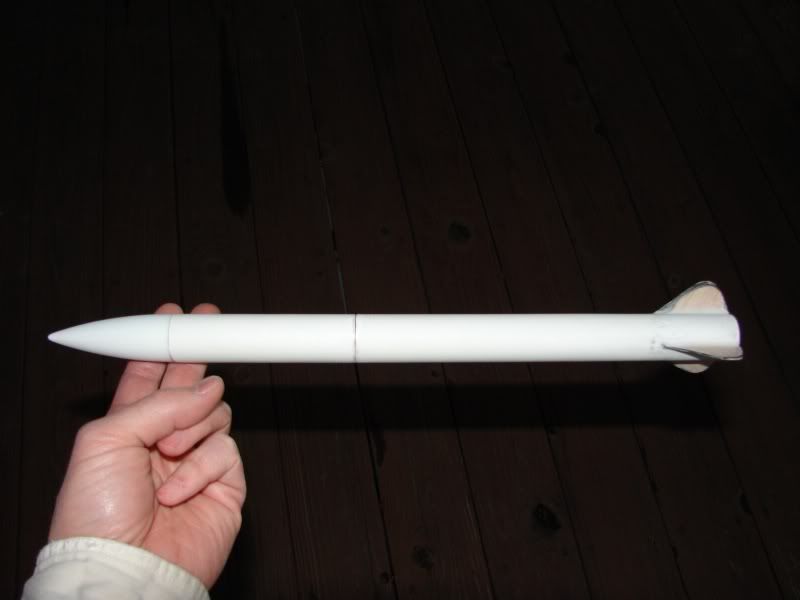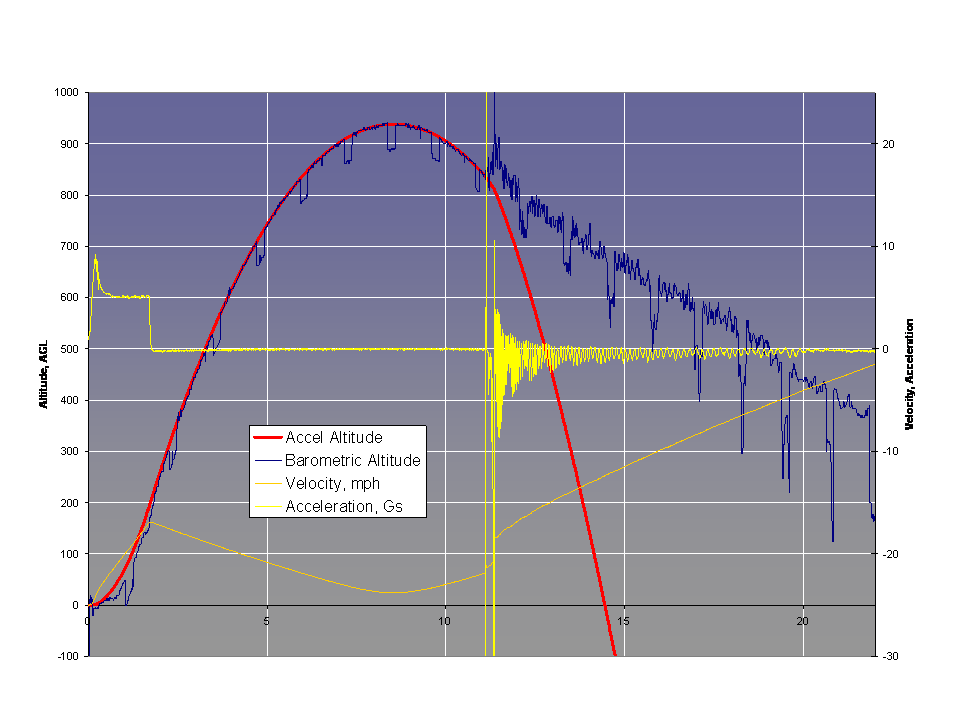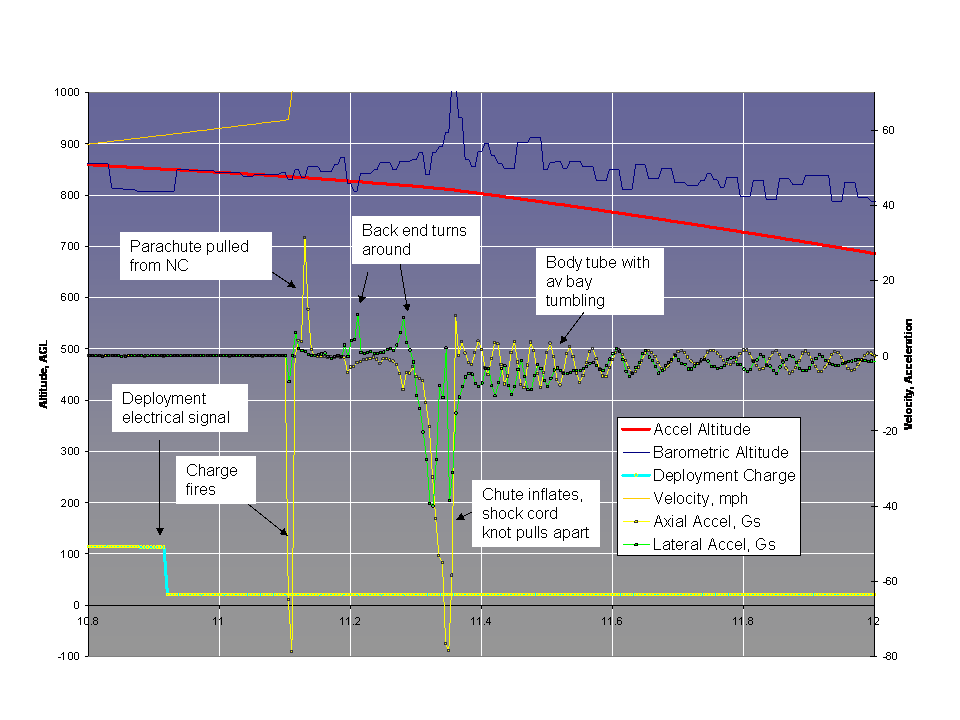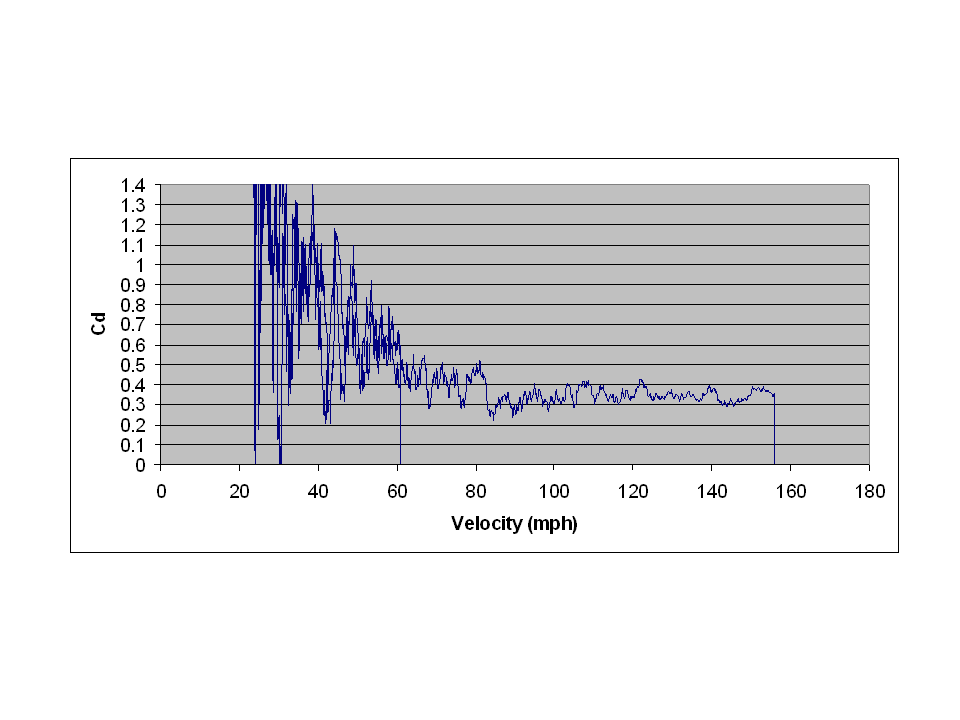More "learning experiences" today.
The avionics bay for this 24mm record attempt bird
uses the same Li-poly cell to power the Beeline transmitter and as a source for the deployment charge. In order to make that work, it means I have to tie the grounds of the transmitter to the Parrot. That results in quite a bit of interference (regular dips in the barometric altitude):

Earlier in the day, I had attempted to launch with the standard Parrot deployment code, and I got a premature deployment because of the interference. So I experimented with modifying the code for this launch in an attempt to make it less likely to have the same problem. This caused the very late deployment shown above. Note that: 1) I would not sell a Parrot with the code in this configuration, and 2) the Parrot is only susceptible to interference from a Beeline when the two are electrically connected together. RF EMI is o.k. I was just trying to do a quick work-around, and it bit me here.
The rocket was out of sight pretty quickly, despite launching on a D11-P motor (1/7th the design-to impulse) clear blue skies. Then I saw the chute. Yay!... Hmm... it's taking a long time to come down... uh oh, it's REALLY taking a long time to come down. 🙁 I still hear a signal on the Beeline, so I decided to leave the rest of the rocket alone and start running after the chute. After about 3/4 mile of running, just keeping up with the 5-8 mph winds and seeing the little chute overhead, I got to the top of a ridge, winded, and saw the chute land about 3/4 of a mile away. A long trudge including some trespassing got me to where I could have sworn I saw the chute land. No chute. Must have blown away. 😥
After a long trudge back and some trouble hearing slight differences in the Beeline signal strength, I found the back end of the rocket, core sampled. I never did find the heavily weighted nosecone. The remainder of the shock cord looked like the whole section of the 300 lb kevlar I was using, which gets blasted by the deployment charge. I think my knot connecting the 300lb kevlar to the 100lb kevlar came undone.
Here are details of the deployment:

Note that both the deployment charge and the chute deployment were 70 Gs. But the rocket is so light that only works out to 12 lbs. So despite the late deployment that should have been o.k. Bad knot, I guess.
About the only bright note from the flight is the following Cd data, which corresponds well to Rocksim's estimate with polished surfaces. (they were pretty much 300 grit matt, by the way)
I think the moral of the story is that I will need to give up on sharing a cell between the Beeline and the deployment charges when I rebuild the rocket. Next up: testing to see just how small of a cell will still work for deployments. Maybe I can use 2 small cells in place of the 3 gram brute I've been using. 8)
First a correction:
It turned out that sharing a battery between the Beeline and the Parrot wasn't the root cause of the interference; simple proximity was. I wasted most of Thursday getting the avionics bay set up again with separate batteries only to find out that the interference was still there, worse than before. I wasted more time with shielding, which helped a little, but was too unrepeatable. So, running out of time, I decided to totally re-work the interior of the rocket, and change it up to put the Parrot on top, then the parachute, and then the Beeline next to the motor. Those few inches of separation between the Parrot and beeline eliminated the interference, but set me up for the problems we saw Saturday afternoon.
Now the interior of the rocket was about 1.5" longer than it would have been. I had made the nosecone half of the rocket extra long when I rebuilt it, expecting to cut it down a bit when I found out just how big the insides were, but now it wasn't quite long enough. To make a little more room, I added a 1/4" section of AF tube to the coupler. The trouble was that (1), 1/4" wasn't quite long enough so that the gap between the top half and the bottom half wouldn't quite close when everything was packed in, and (2) the coupler overlap section was shorter. The result was that the heavily-weighted top half of the rocket was just a little floppy when it sat on the bottom half. I think that the top half of the rocket bent over a bit and gave the CG a radial offset from the thrust line, which is why the rocket corkscrewed so badly coming out of the tower.
Normally I also start timing at launch and note when the Beeline signal gets fainter or goes away. In the heat of the moment, though, I didn't, so I'm not sure exactly when the signal ended abruptly. But it was about 30-60 seconds into the flight. Bad news. I searched for hours on Saturday evening and never did pick the signal back up. I'm pretty sure that the rocket came in ballistically. At about 3:00 AM on Sunday I woke up and realized what I did wrong. When I prepped the rocket at the pad, I slid the avionics bay along the shock cord and deep into the nosecone part of the airframe, and then did the same thing with the piston. Instead, after the airframe was in place, I should have sealed off where the cord went through the piston while the piston was out of the airframe, and then let the cord bunch up between the piston and the avionics bay. As it was, the only way that the piston could have come out would have been to break the shock cord or to magically unwrap the necessary length of shock cord from the parachute compartment so that it could get through the hole in the piston when the piston was trying to get out. Argghh.
Next time, I'll do a better job with the airframe to make it stiffer, with more glass all around, and longer, carbon-fiber coupler. Also, the new version of the Parrot will have 3 outputs. Now I think I'll make the 3rd one a switch to turn the Beeline on at Apogee (or maybe after the main deployment) so that I can still put the Parrot and Beeline next to each other to save space, and still eliminate the interference problem.
Oh, and more testing with plugged C11s or D12s at home before loading up with a G37 with a checklist.
Designing is fun, but starting from scratch sucks.
Don't feel bad Adrian. In my quest for those Wilke records, I've built a successive series of 5 birds and all but the first and the last are lost somewhere out on the prairie.
Aeolus 1 - Took club E record during a test flight. It really wasn't optimized for the motor and was about 1.5" too long and 18 grams too heavy. Intended for the F21.
Aeolus 2 - Almost identical to Aeolus 1 except smaller fins. Flight 1 got within 40-60 feet of Wilke's then standing F altitude record on a much smaller motor. Lost on 3rd attempt.
Aeolus 3 - Lost on maiden flight. Newer design with 2 separate zipperless booster sections to handle both F32 and G55 motors.
Aeolus 4 - Lost on maiden flight. Identical to Aeolus 3.
Aeolus 5 - Un-flown. Identical to Aeolus 3, but somewhat modified to provide room for Adept tracker and only have G55 booster section. Unfortunately, the tracker doesn't fit and the electronics bay needs to be rebuilt. Haven't had the balls to fly it because I don't want yet another Perfectflight altimeter to end up lost on the prairie.
What needs to happen is for just 1 of John's records to fall and I would bet real money (or a bottle of good scotch) that as soon as folks realize John isn't unbeatable, others will try. Personally I think the F and G records are nearly unbeatable - at least as a TRA world record - because the motors just aren't available. However, the H, I, J, K, and L club records are all within reach of good design, construction, and tracking technique. Chris LaPanse came within a hair's breath of it last year and it can be done again.
I think your Parrot is a technology breakthrough in terms of size and capability that will allow it to be done.
Warren
Aeolus 5 -
Thanks, Warren. Interesting history. Was Aeolus-1 the "Momentary Lapse of Reason" listed in the altitude records?
What needs to happen is for just 1 of John's records to fall and I would bet real money (or a bottle of good scotch) that as soon as folks realize John isn't unbeatable, others will try. Personally I think the F and G records are nearly unbeatable - at least as a TRA world record - because the motors just aren't available. However, the H, I, J, K, and L club records are all within reach of good design, construction.......
They are ALL beatable, trust me. I've incremented each of them, and none of the rockets was what I would consider complex. Well built, yes - but as you guys know, I own no tools 😯 so if I can do it, y'all can do it.
The M is probably the most attainable now (though one needs a higher waiver, etc.) which is why I am trying to bust it this summer. I'm doing a project with someone to increment the H and I records. To me, the one that is the most perplexing is the K - no good motor for that. The Loki K350 hardware just weighs too much and is too long... I wish another motor was available?
The dog collar thing has opened up a bunch of doors, too!
Yeah, the Aeolus moniker was the name I gave the design series. Each individual bird ends up with a different name that actually ends up on the flight cards.
The actual Aeolus series were the Aeolus E, the Aeolus F/G (Aeolus 1), Aeolus 29, Aeolus 38, and Aeolus 54. Nothing but a geek with an urge to overcomplicate something... The Aeolus 38 flew as "Can't Buy a Thrill" and the Aeolus 54 will eventually fly (if we get a waiver window or I get to BALLS) as "Delicate Sound of Thunder".
As a matter of facts: the Aeolus E got chewed by one of my dogs after successfully taking the club E record (possibly world record, but TRA doesn't recognize one and NAR's records don't allow for electronics). There have been several Aeolus F/G birds built - 3 are out on the prairie somewhere and the 4th is on the shelf in my shop. The Aeolus 29 was cannabilized to become my Single Shot Sweepstakes bird when we used the H180 motor. Can't Buy a Thrill was a shot at the J record using a J570 and it suffered heavy damage on recovery due to too much BP behind the piston as well as impact damage. Parts of it are on the shelf waiting for me to buy some more airframe and new fins. Delicate Sound of Thunder is designed around the Ellis L330 and AT L1500T. It's been ready to fly for nearly 3 years, but either the waiver hasn't come through, the weather sucked, or tracking wasn't available.
W


